8 Math Games to Practice Simple Addition.

As a homeschooling family, board games have become an important part of our daily learning. We often play at least one board game during our math lesson and there are lots of great board games out there that help build different math skills! Recently, we have been working on addition facts up to 10 and games have been a staple at building math fluency!
However, you don’t need to be a homeschooler to benefit from playing games at home! Games can be an effective learning tool for any child. One thing that I love about playing board games with my kids is that they don’t even realize that they are learning! The games in this list are so fun and engaging for kids that mine often ask to play these games! If you have a child working on simple addition (or subtraction) problems, check out the list below for board game recommendations to play with your child as they develop those math skills!
This post may contain affiliate links. As an Amazon Associate and participant in other affiliate programs, I earn a small commission on qualifying purchases (at no additional cost to you). Thank you for your support! Read our affiliate disclaimer here.
Ten Frame Towers by Educational Insights
This game has quickly become a favorite of my 4-year-old! During our game nights, this is often the game he picks for us to play. One thing that I like about this game is that it doesn’t require the child to know the number symbols in order to play.
To play this game, you roll the dice to collect pieces. Once you have a combination that equals 10, you place them in your stack. The game ends once all of the pieces have been collected and the highest stack wins!
This game is great for practicing number bonds that equal 10 in a fun way! I love that the pieces are designed to look like traditional ten frames (two rows of 5) and the shape of the pieces allows kids to visualize the number that it represents. The shape also makes it easy to learn if a number is an odd or even number. With practice kids can quickly see what combinations are needed to make ten!
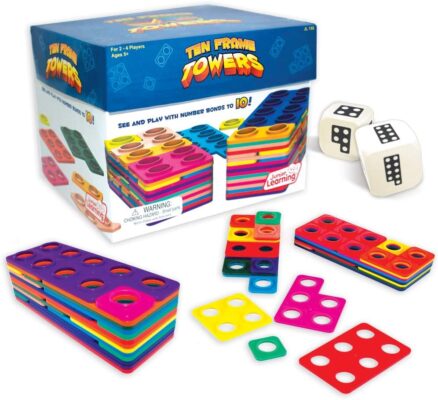
Sum Swamp by Learning Resources
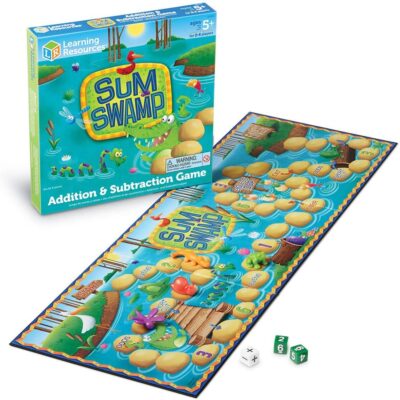
This is a favorite game to practice simple addition! On your turn, you roll three dice to form an addition or subtraction equation. Find the answer to the equation and move your piece along the game board. The game pieces are adorable swamp creatures (dragonfly, crocodile, snail and frog). The colorful game pieces are a similar design and material of other math counters made by Learning Resources (we own the dinosaur counters). This game is one of my top picks for kids preschool to first grade that are learning addition and subtraction.
It’s also very easy to modify the gameplay- when my kids were focusing on addition problems, we modified the game by only rolling the number dice and always using the two numbers to form addition problems.
Bus Stop by Orchard Toys
In Bus Stop by Orchard Toys, kids practice simple addition and subtraction as they add or remove passengers from the bus.
To play, you roll the dice and move your bus along the road on the board game to either land on a “+” sign or “-” sign. This indicates if you will be ADDING passengers to your bus or REMOVING passengers. The player then spins the spinner and lands on a number 1-6. This indicates HOW MANY passengers you will add or remove from your bus. Players continue taking turns until each bus makes its way around the board and arrives back at the bus station. The player with the most passengers on their bus when they arrive wins!
Overall, this is a simple game to practice counting and simple addition and subtraction. I love that as a player is adding or subtracting, they are physically adding or removing the passengers from their bus, so they can see how the total number of passengers change. When playing math games like this, I recommend practicing to say the corresponding equations out loud, as this extra step is valuable practice as the child is learning addition and subtraction. For example, the child has 3 passengers on their bus and on their turn, they are adding 3 more passengers. The child would also practice saying the corresponding equation: 3 plus 3 equals 6.
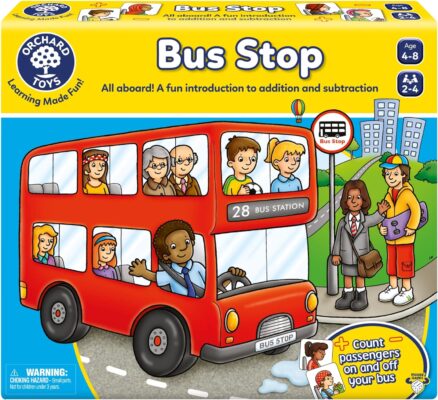
Zingo! 1-2-3 by Think Fun
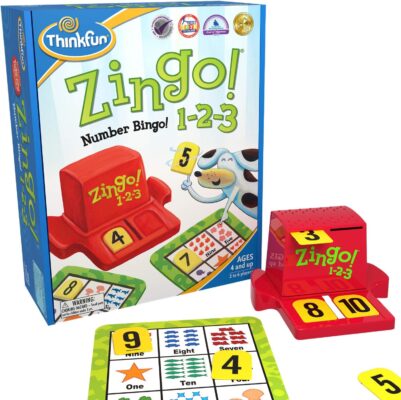
Have you tried this fun take on “bingo”? Zingo! is an absolute favorite game in our house! I first bought the original Zingo! game and I was ecstatic when I realized there was a math version! This was one of our first math games that I purchased. With this game, you use the special “Zinger” to dispense two tiles. All players quickly look to see if one of the tiles matches a space on their game card and grab the number tile. The first player to fill their board and yell “ZINGO!” wins!
There are two levels of play with this game. One side of the game card is perfect for younger kids practicing their counting skills. Each square includes a number of objects between 0-12 that you match to the number on the tiles. The other side of the game card is great for older kids practicing their addition skills: each square includes two sets of objects that you must add together to find the sum, and then collect the matching number tile.
Math Swatters by Learning Resources
Any game that involves movement is a winner in our house! With Math Swatters by Learning Resources, you use a toy fly swatter to be the first to swat at a cardboard fly with the correct number or math equation. Math Swatters is another math game that can be played multiple ways. One way to play is by rolling three dice to practice writing addition and subtraction equations from 0-10. The players find a fly with the answer to the equation and use their fly swatter to tap the number before collecting it. For extra practice, I like having my little learners say the full equation as they collect the number. For example, the child would say: “3 plus 2 equals 5.” For a second way to play, you flip the cardboard flies to reveal different addition and subtraction equations (for example, “2 + 2”). For this version of the game, you spin a spinner that lands on a number 0-10. The players look for a fly with a corresponding equation. For example, if the spinner lands on “3”, you could look for a fly with the equation “2+1” or “5-2”. This version is more challenging, but is a great way to practice number bonds up to 10!
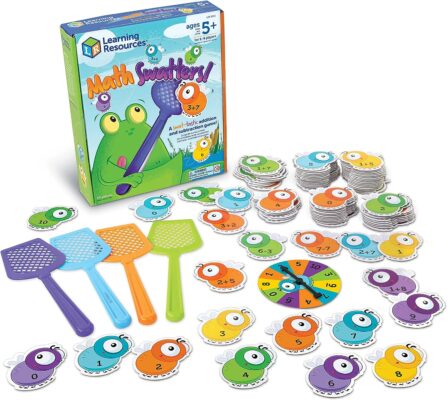
I Sea 10 by Learning Resources
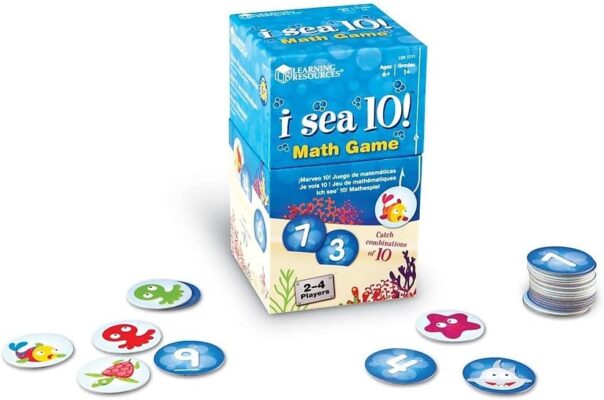
Learning Resources makes a lot of great math games, and “I Sea 10” is a new favorite for practicing number bonds that equal 10. With this game, you make combinations to 10 using cards with the number symbols. Take turns flipping cards (and flipped cards remain number side up). When you see a combination that equals 10, say “I See 10!” and collect the cards. You can also use this game for practice stating math facts as players collect cards, for example, you would say: “6 plus 4 equals 10.” The game includes “shark cards” that require a player to put back all of their matches if flipped. But gameplay can easily be modified to remove the shark cards from play, if you don’t want to include this element!
Clumsy Thief Junior by Melon Rind
With this card game, you add together cards that equal 10 to create stacks. But other players can take your stack and place in front of themselves! Combinations that make 10 have corresponding fruit/vegetable images on the cards (this makes seeing the pairs easier), along with the the number symbols. The rules of this card game can be easily modified to slow the game play for beginner players.
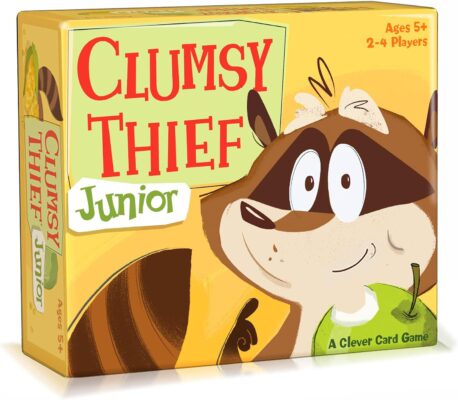
Simple Math Bingo by eeboo
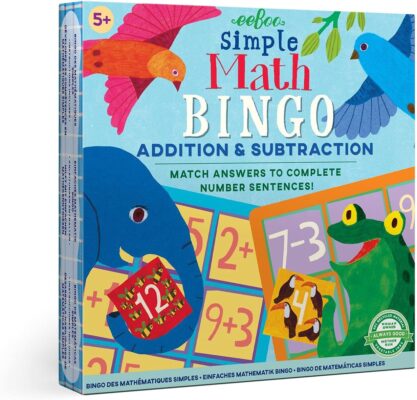
Choose a number tile and see if the number is the answer to one of the equations on your board. This is a simple game to help build mental math skills and math fluency. The first player to fill their board is the winner! With this game, you can practice addition or subtraction, as one side of the cards include addition problems and the other side of the cards include subtraction problems.
Bonus Game: Fish Stix by Peaceable Kingdom
When I initially wrote this article, I intended to only include eight games. However, recently we started playing the game Fish Stix by Peaceable Kingdom and I realized it is a great game for also practicing addition facts up to 10! Players take turns adding game pieces to the playing space to create schools of matching fish. When you add your game piece, you count how many matching fish are in a row and you add this to your score sheet. The game play is a great opportunity for practice stating math facts. For example, a player already has 3 boxes marked on their score sheet and they get 3 more on the current turn. To practice math facts, the player can state “3 plus 3 equals 6.”
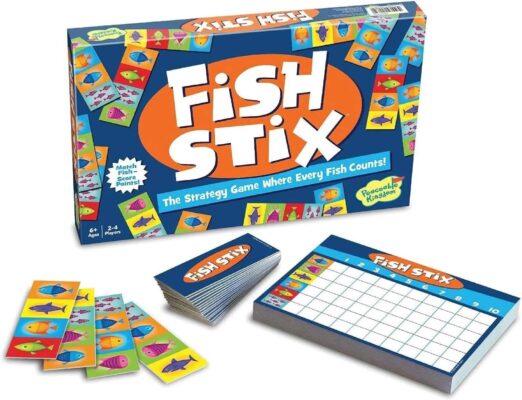
Bonus Game: Glow Spotters by SimplyFun
Glow Spotters by SimplyFun is a math game we just discovered! During gameplay, players learn various ways to reach sums 1 through 10. It’s a great game for developing number sense and being able to see numbers in patterns. Each player has 10 Firefly Boards (one for each number 1-10). Players take turns collecting Glow Tiles to fill their boards. The Glow Tiles are numbers 1-5 arranged in different patterns. Players must collect Glow Tile patterns that will fit the open spaces on their boards. Players work on filling two Firefly Boards at a time. Once a player completes a board, they say the equation they used to reach the sum. For example, “2 + 2 + 3 = 7”. The first player to complete all ten of their Firefly Boards wins!
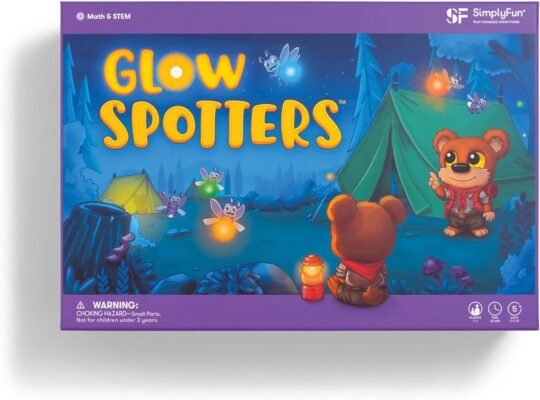
You may also be interested in:
Seven Great Games for Preschoolers
Six Engaging Board Games for Early Elementary
Favorite Board Games for 4-year-olds
Favorite Board Games for 5-year-olds (coming soon)
Favorite Board Games for 6-year-olds (coming soon)
